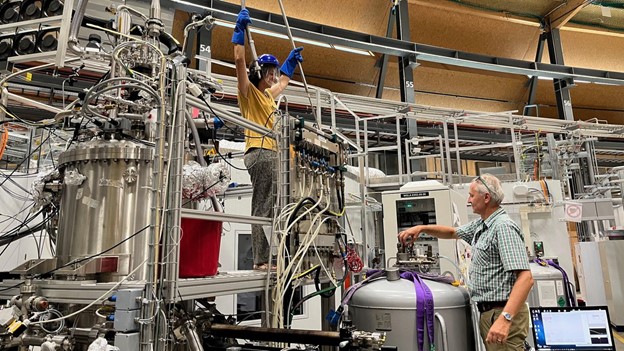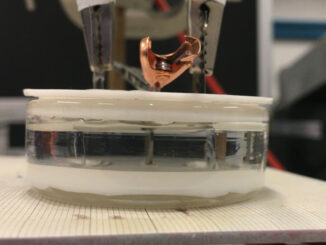
A research collaboration co-led by EPFL has uncovered a surprising magnetic property of an exotic material that might lead to computers that need less than one-millionth of the energy required to switch a single bit.
The world of materials science is constantly discovering or fabricating materials with exotic properties. Among them are the multiferroics, a unique class of materials that can be both magnetized and polarized at the same time, which means that they are sensitive to both magnetic and electric fields.
Having both these properties in a single material has made multiferroics very interesting for research and commercial purposes with potential applications from advanced electronics to next-generation memory storage. By understanding and harnessing the properties of multiferroics, researchers aim to develop more efficient, compact, and even energy-saving technologies.
Now, an international research collaboration has uncovered some fascinating properties for the multiferroic Manganese-doped Germanium Telluride (Mn-doped GeTe); the “doped” part of the name simply means that a small amount of manganese (Mn) atoms has been introduced into the germanium telluride (GeTe) crystal structure to modify its properties. The work holds promise for the future of energy-efficient computing but also offers a deeper understanding of the collective behaviors in multiferroic materials.
The project was led by Professors Hugo Dil at EPFL, Gunther Springholz at Johannes Kepler University Linz, and Jan Minár at the University of West Bohemia.
Mn-doped GeTe is known for its unique ferroelectric and magnetic properties. But the new study has now found that it also possesses a magnetic order distinct from typical ferromagnets, such as iron, which align with a magnetic field. Instead, the scientists found that Mn-doped GeTe exhibits the characteristics of a ferrimagnet.
What is a ferrimagnet? Unlike “normal” magnets like the ones we stick to our fridges, a ferrimagnet is more like two magnets with slightly different strengths superimposed on top of each other. The discovery that Mn-doped GeTe behaves like this means that we now have more flexibility to control the direction of magnetization – an essential feature for a number of technologies.
This proved to be important, as it allowed the scientists to develop a method for enhancing the efficiency of switching magnetization direction by an astounding six orders of magnitude. Instead of doing this in the traditional way of applying a large current pulse to Mn-doped GeTe, they instead used a small, constantly fluctuating (AC) electrical current, followed by a tiny current nudge at just the right moment – a bit like pushing a swing at the right time to make it go higher with less effort. The researchers named this phenomenon “stochastic resonance”.
This tiny “nudge” caused a change that spread quickly throughout Mn-doped GeTe, like a ripple in a pond. This happened because the material behaves a bit like a solid and a bit like a liquid – essentially a glass: a change in one part causes a chain reaction that changes other parts.

To put in a more technical way, the magnetic switch propagated swiftly across the Mn-doped GeTe through collective excitations, which are coordinated collective movements of a large number of electron spins within the material. “This is possible because the system forms a correlated spin glass, where the local magnetic moments are in a glassy state, similar to atoms in an old-fashioned window,” says Hugo Dil. “If one spin is forced to change its orientation, this information will travel like a wave through the sample and cause the other magnetic moments to also switch.”
He adds: “For technological applications, this increase in switching efficiency is of course very interesting. It can eventually lead to computers that need less than one-millionth of the currently required energy to switch a bit. However, as a physicist, what really intrigues me is the collective behavior. We are now planning space- and time-resolved experiments to follow how these excitations spread and how we can control them.”
Full list of contributors
- EPFL
- Paul Scherrer Institut
- Johannes Kepler Universität
- New Technologies-Research Center University of West Bohemia
- Masaryk University
- P. J. Šafárik University
- Slovak Academy of Sciences
- CY Cergy Paris Université
- Institute of Physics ASCR, v.v.i
- Charles University
- Funding
- Swiss National Science Foundation (SNSF)
- Computational and experimental design of advanced materials with new functionalities (CEDAMNF)
- Ministry of Education, Youth and Sport of the Czech Republic (MŠMT)
- Austrian Science Funds (FWF)
- Czech Academy of Sciences (Lumina Quaeruntur fellowship)
- Slovak Academy of Sciences
- References
- Juraj Krempaský, Gunther Springholz, Sunil Wilfred D’Souza, Ondřej Caha, Martin Gmitra, Andreas Ney, C. A. F. Vaz, Cinthia Piamonteze, Mauro Fanciulli, Dominik Kriegner, Jonas A. Krieger, Thomas Prokscha, Zaher Salman, Jan Minár, J. Hugo Dil. Efficient magnetic switching in a correlated spin glass. Nat. Comm. 14, 6127 (2023). DOI: 10.1038/s41467-023-41718-4
- Author: Nik Papageorgiou
- Source: EPFL



